A couple of weeks ago, I went hiking with a local Meetup group. I love to hike, but I especially wanted to go on this adventure because we were also going apple picking.
I had been waiting for apple season so I could get some apples for a special peasant bread. This particular bread uses a sourdough starter made from hazy apples; the kind you can only find at a local market stand or better yet, on a tree.
The title of the Meetup was “Apple of my Hike”. It was such a great play on words, I decided to name this post after it. I would like to give special thanks to Dante, our hike leader, for the inspiration.
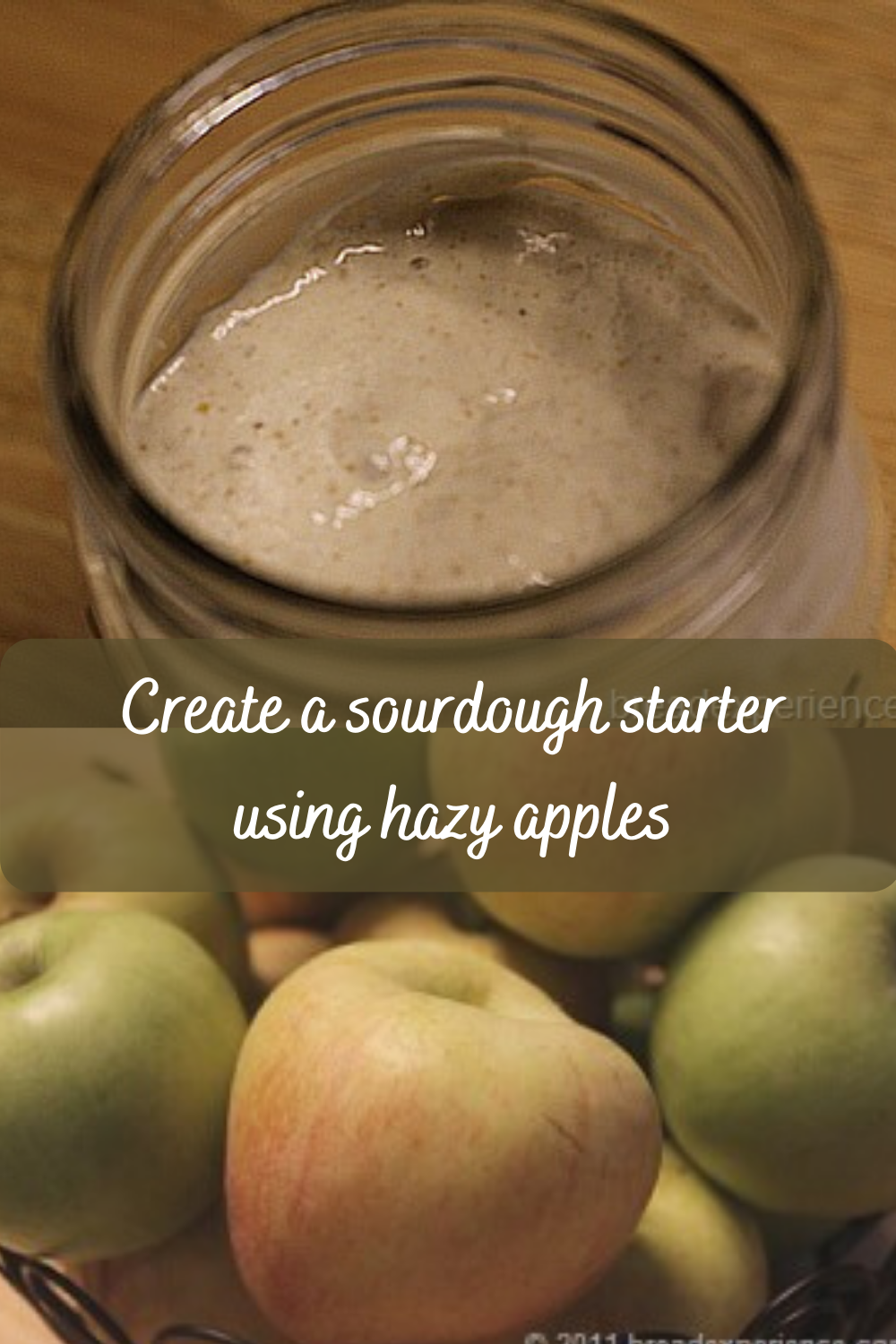
Before we got started on the hike, we visited Mercier Orchards, in the North Georgia Mountains. They had so many different types of apples, I had a hard time choosing which ones to pick. They have 200 acres with 100,000 trees. It was awesome!
After tasting several of the apples and asking the kind guides in the Orchards, I finally decided on a combination of Granny Smith and Jonagold. The Orchard guides said these two apples were a good combination for canning. I thought I might also make some apple butter, in addition to using some in this starter, but the apples were so good I just ate them.
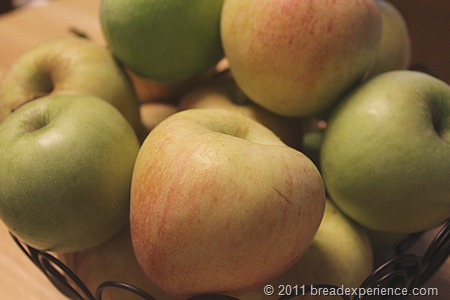
Here are the apples I used in this starter
Building an Apple Sourdough
Adapted from: William Alexander’s 52 Loaves
This starter is so easy to make! It takes a few days, but it’s worth the wait. It smells great while it’s fermenting and it’s easy to maintain.
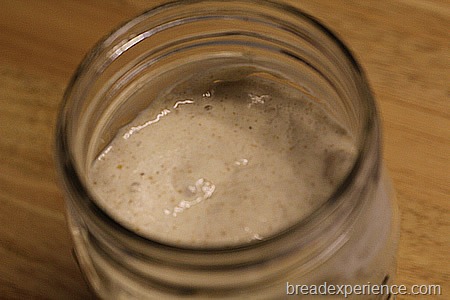
Ingredients:
- 2 hazy apples *
- 1 quart (4 cups/32 oz./950 ml) tap water
- 50 g (~1/3 cup/2.75 oz.) whole wheat flour
- 350 g (2 1/2 cups/12.50 oz.) unbleached bread flour or all-purpose flour
*If you aren’t able to find organic apples, or pick them off the tree like I did, clean the skins with boiling water.
Directions:
Prepare the apple water:
Let 1 quart of tap water sit out overnight to remove any chlorine.Look for a hazy apple, preferably from a farm stand (the haze is wild yeast). Cut the apple into 1-inch chunks, and place, along with the peel of a second apple, into a container with 1 cup of the water. (Cover and reserve the remaining water for later.)
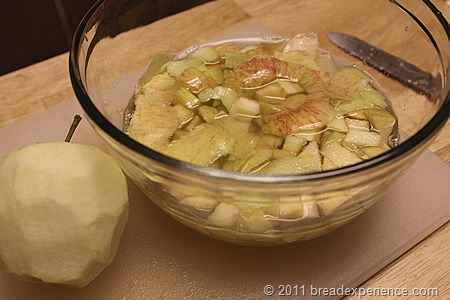 I used one whole Jonagold apple and the peel of another one. While I finished making the starter, I enjoyed munching on the rest of the second apple… I couldn’t let it go to waste.
I used one whole Jonagold apple and the peel of another one. While I finished making the starter, I enjoyed munching on the rest of the second apple… I couldn’t let it go to waste.
Let the apple and water sit covered, at room temperature, for 3 days, stirring daily. The mixture should be foaming a bit and smell a little like cider by the third day.
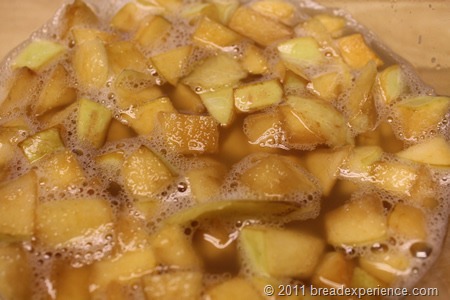 Build the levain:
Build the levain:
Day 1
Combine 50 g of whole wheat flour (preferably organic) with 350 g unbleached all-purpose or bread flour.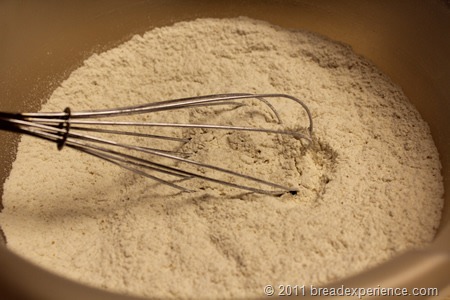
Measure out 150 g of the apple water through a fine strainer and add 150 g of the flour mixture.
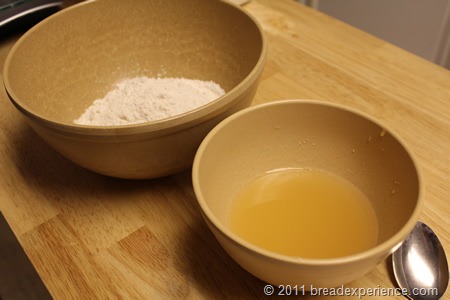
Whip vigorously, scrape down the sides, and cover with a screen (a frying pan spatter screen is ideal) or cheesecloth.

Leave the levain at room temperature, whipping every few hours to incorporate air. It is important to keep the starter aerated during the first few days.
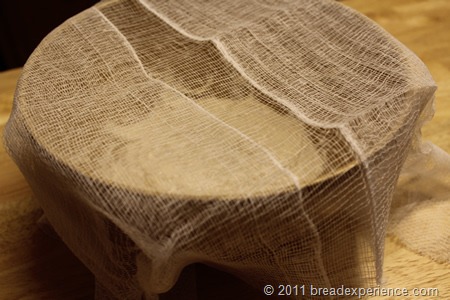
[includeme file=”includes/responsive-sourdough-bottom”]
Day 2
Add 75 g of the reserved tap water and 75 g flour, whip, and leave at room temperature, covered as before, for another 24 hours, again whipping occasionally. You should see bubbles starting to form and the mixture increasing in bulk.
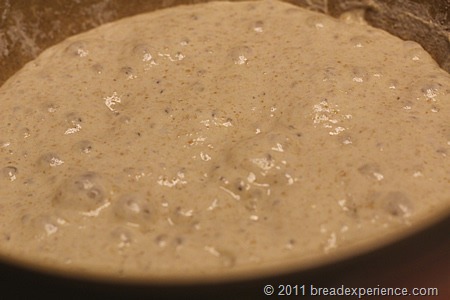
Day 3
Transfer levain to a clean 2-quart container. Avoid transferring any of the dried bits from the sides of the old container.
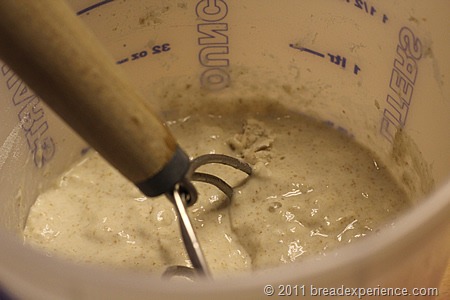
Add 75 g each of bread flour and reserved tap water, whip and cover as before.
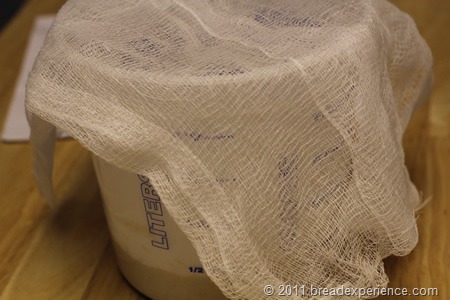
If at any point of this process, the levain starts to smell a bit funky, discard half, replenish with flour and water and whip more frequently. If the levain seems limpid (not rising and bubbling), increase the frequency of feedings.
Day 4
Feed it once again, with the remaining 100 g of flour and 100 g water, let it sit at room temperature for 2 to 3 hours, and your levain should be ready for use, although it will continue to develop flavor over the next few weeks. You can either use it in bread today or go to the next step.
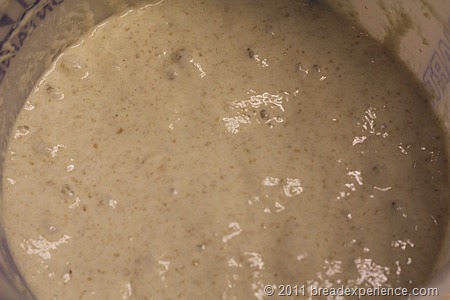
Cover with an airtight lid, store in refrigerator, and follow the care and feeding directions below.
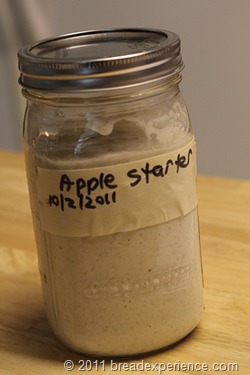
Care and feeding of your levain:
A levain gets easier to care for with age. Just observe the following guidelines:
- Keep the levain in a covered container in the refrigerator.
- For the first few weeks, feed twice a week as described in the next step; afterwards, a weekly feeding is sufficient.
- To feed, stir thoroughly and discard about 250 g of levain. Replace with 125 g water (straight from the tap is fine at this point) and 125 g flour (unbleached bread or all-purpose), and whip with a spoon or plastic spatula. Leave the lid ajar (so gases can escape) at room temperature for 2 to 4 hours before tightly covering and returning to refrigerator.
- If you are baking regularly, feeding is simply part of preparing the levain for the bread, and no other feeding is necessary. You should always feed the levain several hours or the night before making bread, so replenish with the amount of levain the recipe calls for, and you maintain a constant supply of fresh levain with no effort.
- Occasionally clean out your container with hot water (never soap) to remove the crud that forms on the sides.
- If you want a stronger levain, leave it out overnight once in a while, and feed with smaller “meals.”
- You may see a puddle of liquid forming on top, a product of fermentation. It can simply be stirred back in, but if you want to remove it, place the container of levain on your digital kitchen scale, and zero out. Pour off the liquid, return the levain to the scale and replenish with fresh water and just a little flour (in a ratio of about 3 to 1) until you’re back at zero. Then feed as usual.
Thanks for joining me for my apple-picking adventure. It was a lot of fun. In fact, the next week, my youngest son was home from college so I took him to Mercier Orchards and we got more apples (and more photos). My son had a great time! It was funny to see my college-age son running around the orchard looking for the perfect apple. He found it – a huge Pink Lady!
This post, on Making an Apple Starter. is Part #1 in my apple series.
Part #2 is making Peasant Bread.

Part #3 is making Tomato Bread Soup using bread cubes from the Peasant Bread and fresh tomatoes from my garden.

Happy Baking!
Cathy
girlichef says
Wow, this is SO cool! I think I’m definitely going to have to try it. I have a whole bushel of just-picked apples!
Cathy (breadexperience) says
I think you should try it Heather. It’s easy and fun!
Elwood says
Started mine today. Of course, being a beekeeper I used Honeycrisp apples. 🙂 I have a starter that I use all the time. Now I’ll have two! Thanks for the post.
Cathy (breadexperience) says
Cool! Honeycrisp apples – yum! I’m interested to find out how your starter turns out. I have 3 starters now but I like this one so much, I’ve been using it in the past several breads I’ve made. The flavor still needs to develop, but so far so good. 🙂
Anonymous says
My grandson and I started this as a summer school project. I had tried making starter before but was not successful. With these easy to follow instruction we are right on track to finish Monday. The only problem we had was converting grams to cups but use a converter system. Thanks for making it easy. Carson and Peggy, California
Cathy W. says
I’m so glad you found these instructions helpful. Using a converter was probably a good exercise for your grandson as well. Let me know how your starter turns out. This is my favorite starter. I use it all the time.
Karen Murphy says
Do you have a recipe for the bread once the starter is ready. Preferably not a white one. Excited about stating this starter today.
Thanks for sharing
Karen
Cathy says
Hi Karen, you can use this starter with any sourdough bread recipe. Happy Baking!
Tiffany says
Can you explain what a hazzy apple is?
How does this change the flavor of a regular sour dough starter? Or why is it your favorite? Does it have any added benefits?
I’ve been doing sourdough for 7 months now and love it!
Cathy says
Hi Tiffany, hazy just refers to an apple that is picked off of a tree and hasn’t been treated or waxed. Supposedly, you aren’t supposed to wash it either, but I did. It doesn’t change the flavor of the sourdough starter, it’s just an easy way to get it going. Some people have trouble with sourdough starters and this makes it really simple. It’s my favorite because it is associated with a fond memory of hiking in the mountains and picking apples. I use mine all the time. It works the same way as a regular sourdough starter. I have a starter that I started with grapes as well. You don’t have to use anything but flour and water to make the sourdough starter, but for me, it’s fun to try different methods. I love working with sourdough as well.
Joyce says
Hi,
This starter sounds great. Can you do the same thing with grapes? At the farmer’s market they sell grapes that also have a haze on them. Is it wild yeast on them? Thanks
Cathy says
Hi Joyce, yes you can use grapes to start a sourdough starter. Here is the method. https://www.breadexperience.com/making-sourdough-bread-using-natural/ This was one of my earliest experiments with sourdough (and photographing bread) so the photos are not so good, but the method works. I’m still using the grape starter. I call it #1 and the apple starter is AP. They both work interchangeably now that I’ve been feeding them for several years.
Christine says
Hi Cathy. I make apple cider vinegar and have extra mothers. Can I use a mother from apple cider vinegar to make a sourdough starter?
Cathy says
Hi Christine, I’ve never tried that although I’ve heard that some people have used kombucha to ferment their breads so perhaps it could work.
Emily says
I used Transparent apples from our farm — very old trees. Transparent is the first variety to ripen here, and I happened to have some in my kitchen when I read about this technique. I just added the flour to the apple water last night, and this morning I have a very large, bubbly sponge! And it smells great. I’m excited!
Cathy says
Hi Emily, that’s very cool! Thanks for sharing. I’ve never heard of Transparent apples – how neat that they grow on your farm.
Ryan says
Just made a starter using your directions. Great job making it simple to understand! I’m using Crab apples from a tree in my yard and it’s working great so far. Baking and brewing… Where chemistry and biology meet in a delicious way!
Cathy says
Cool! Happy Baking and Brewing!
Danny K. says
Hello. Best site yet very clear to understand and layed out perfectly. Question: for the apple starter you mentioned 350gr or 2.5 cups. My conversion has 2.5 cups=591.47gr. Bit of a difference. I’m using https://is.gd/G1o35L to convert I apologize if I’m using the wrong site. Thanks!
Cathy says
Hello Danny,
Thanks for visiting my site. So glad you like it! Typically, bread flour weighs about 140 grams per cup so 2 1/2 cups of bread flour would be 350 grams. For this method, you’ll begin by mixing 50 grams of whole wheat and 350 grams of bread flour together. Then you’ll use 150 grams of that mixture, then 75 grams, then another 75 grams and then the remaining 100 grams for a total of 400 grams of flour. Hope this helps.
Happy Baking!
Cathy
pearl says
can I use rye flour instead and does it always need to be in the fridge? sounds very cool and i want to try!
Cathy says
Hi Pearl,
I haven’t tried this particular method with rye, but it is a fun experiment. I don’t see why it wouldn’t work with rye. If you try it, let me know how it goes. You might also enjoy this post devoted to creating a sourdough rye starter https://www.breadexperience.com/developing-sourdough-rye-starter/
While creating the starter, you don’t need to put it in the fridge; however, after it is established, unless you plan to bake and feed it everyday, it makes more sense to place it in the refrigerator between feedings. Otherwise, it might go bad.
Pearl David says
so far Cathy so good! I followed your instructions, the only thing I did different is add double hydration on the last day & it floats! I actually used apple water the whole time since mine were from the grocery (i live in the city), the first batch golden delicious, second fuji. I put it in the fridge now as I wanted the taste to sour a bit more before I use it in a bread but I’m really excited to try! Thanks for your help!
Cathy says
Cool! I love golden delicious apples! Let me know how it goes when you use it in bread.